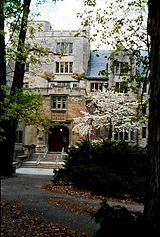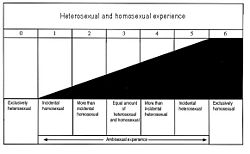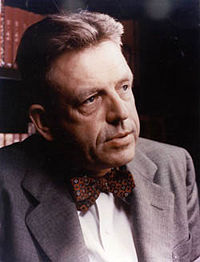Difference between revisions of "The Kinsey Institute"
| (7 intermediate revisions by the same user not shown) | |||
| Line 1: | Line 1: | ||
| − | [[Image:Mors1.jpg|thumb|160px|upright|border|Morrison Hall. The Kinsey Institute occupies the third and fourth floors.]]The Kinsey Institute for Research in Sex, Gender, and Reproduction is one of the oldest research institutes in the United States concerned primarily with the | + | [[Image:Mors1.jpg|thumb|160px|upright|border|Morrison Hall. The Kinsey Institute occupies the third and fourth floors.]]The Kinsey Institute for Research in Sex, Gender, and Reproduction is one of the oldest research institutes in the United States concerned primarily with the scientific study of sexual behavior. The brainchild of Alfred Kinsey, the Institute was founded in 1947 and has been attracting attention ever since, ranging from the Catholic Church’s condemnation to Hollywood’s production of a major motion picture. |
| − | + | Research conducted by biologist Alfred Kinsey at Indiana University in the 1940s and 1950s fundamentally altered the way modern Western societies think about sexuality. Most famously, Kinsey’s research suggested that everyone’s sexuality exists fluidly across a range or spectrum—and that behavior, not subjective identity, is the crucial criterion to study. Kinsey felt there was no such thing as a homosexual or a heterosexual “type” of person, only men and women who engaged, over the course of their lives and to varying degrees, in same-sex or opposite-sex behavior. | |
| − | + | Kinsey became a vital part of the mid-twentieth-century sexual revolution, and he helped set the stage for the gay liberation movement by revealing how common homosexual behaviors are. According to his research, nearly 40 percent of men and a little less than 15 percent of women have had at least one homosexual experience in their lives. In changing the way the world thought about homosexuality and other aspects of human sexual diversity, Kinsey left an indeliable imprint on the city where he conducted his research. He contributed an important element to Bloomington’s reputation as a place where diverse expressions of gender and sexuality can be treated with respect. | |
| − | Alfred Kinsey graduated from Bowdoin College with B.S. | + | ===Kinsey Scale=== |
| + | |||
| + | [[Image:kinsey scale.jpg|thumb|left|250px|upright|border|The Kinsey Scale]] | ||
| + | Kinsey developed an eight-point scale for assigning a numerical value to the frequency of homosexual behavior relative to heterosexual behavior, with 0 representing exclusive life-long heterosexuality and 6 representing exclusive life-long homosexuality. A Kinsey Scale 3 signified a perfectly bisexual balance between homosexual and heterosexual experiences. A Kinsey Scale 1 meant primarily heterosexual behavior with only incidental homosexual behavior, while a Kinsey Scale 2 meant primarily heterosexual behavior with more-than-casual homosexual experience. Likewise, a Kinsey Scale 4 and 5 meant, respectively, a preponderantly homosexual disposition with significant heterosexual experience, and a predominantly homosexual disposition with only incidental heterosexual experience. A final category, X, signified asexuality, or no sexual experience. Kinsey himself scored somewhere between 2 and 4 on his own scale, and he experimented with BDSM and group sex. He maintained a committed and loving open marriage with his wife Clara, with whom he had four children, until they were parted by his death after 35 years together. | ||
| + | |||
| + | |||
| + | ===Kinsey Before the Institute=== | ||
| + | |||
| + | Alfred Kinsey graduated from Bowdoin College with B.S. degrees in biology and psychology. In 1919 he received a Sc.D. in biology from Harvard University, and joined Indiana University’s biology department in 1920, as an assistant professor of zoology. Kinsey was a popular instructor who earned the nickname “Dr. Sex” after the university asked him to teach a course on human sexuality for students who were married or considering marriage. Kinsey, whose academic specialty was gall wasps, quickly discovered that empirical research into actual human sexual activity was exceedingly rare. To remedy this lack of data, Kinsey began interviewing students about their sexual habits in the hopes of compiling information on this under-researched topic. He soon started interviewing a broader range of people across the United States. In 1940, human sex research became his primary project, and in 1947, the National Research Council began funding Kinsey’s collection and analysis of sex histories. That same year, Kinsey established the Indiana University Institute for Sex Research. | ||
===Kinsey’s Research=== | ===Kinsey’s Research=== | ||
| − | Through funding for the Institute, Kinsey | + | Through funding for the Institute, Kinsey began compiling the information he [[Image:Kinsey1.jpg|thumb|200px|upright|border|Alfred Kinsey]]subsequently published in two major books, ''Sexual Behavior in the Human Male'' (1947) and ''Sexual Behavior in the Human Female'' (1953). By the time the research project ended in 1963, after Kinsey’s death, he and his research team had interviewed more than 18,000 people—the largest empirical study of sex practices ever undertaken. Kinsey’s major finding was a tremendous gap between what people said publicly about sex and what they actually did in private. At the time Kinsey published his volume on male sexuality, it was extremely rare to talk candidly about sexual practices, and unheard of to publically discuss many of the particular practices—ranging from bestiality to masturbation to wearing fetish clothing to engaging in homosexual behavior—whose surprisingly common occurrences he documented. |
===Controversy=== | ===Controversy=== | ||
| − | Kinsey sought to provide accurate information about human sexual behavior despite the conflict | + | Kinsey sought to provide scientifically accurate information about human sexual behavior despite the conflict between his data and conventional sexual morality. As a result, his research drew condemnation as well as praise. Clerics and clergymen denounced Kinsey’s findings as “shocking,” “disgusting,” and “distorted,” while scientists called them “necessary,” “enlightening” and “revealing.” (Gilbert 1953). In 1954, after publication of the volume on female sexuality, a conservative member of the U.S. House of Representatives, B. Carroll Reece of Tennessee, formed a special congressional committee to investigate Kinsey’s financial backers, which included the Rockefeller Foundation and other prominent philanthropies. Under immense political pressure from the McCarthyite right, many of Kinsey’s funders withdrew their support. Postal inspectors began investigating criminal charges against Kinsey for receiving pornographic materials—that is, the research items sent to him by sexuality scholars and scientists from around the world, which now form the core of the Kinsey Institute’s unparalleled archival collection documenting the history and practice of human sexuality. Indiana University president Herman B Wells stepped into the breach and put his considerable reputation on the line to secure the support of the Trustees, call off the postal inspectors, and to solicit new financial support from Indiana-based pharmaceutical giant Eli Lilly & Co. |
| − | == | + | ===Death=== |
| − | Kinsey | + | Kinsey died in 1956, at the age of 62, shortly after the controversy over his institute was resolved. He had a weak heart due to a serious childhood illness, but the stress of the conservative witch-hunt against him undoubtedly contributed to his relatively early demise. |
| − | |||
| − | |||
| Line 44: | Line 50: | ||
Schmalz,Valerie. “Alfred Kinsey: Father of Sexual Revolution.” Ignatius Insight. http://www.ignatiusinsight.com/features/vschmalz_kinsey_nov04.asp. | Schmalz,Valerie. “Alfred Kinsey: Father of Sexual Revolution.” Ignatius Insight. http://www.ignatiusinsight.com/features/vschmalz_kinsey_nov04.asp. | ||
| − | [[Category:Before Stonewall]][[Category:Indiana University]] | + | |
| + | <div style="text-align: center;"> | ||
| + | '''Navigation''' | [[The Midwest's "Queer Mecca": 40 Years of GLBTQ History in Bloomington, Indiana (1969-2009) | '''Home''']] | [[BEFORE STONEWALL: WHAT MADE BLOOMINGTON A GAY OASIS? | '''Before Stonewall''']] | [[FROM STONEWALL TO THE AIDS EPIDEMIC: 1969-1981 | '''Stonewall to AIDS: the 70s''']] | | ||
| + | |||
| + | [[AIDS, ACTIVISM, AND COMMUNITY VISIBILITY: 1981-1991 | '''AIDS and Community Life: the 80s''']] | [[QUEER BLOOMINGTON: 1992-2001 | '''The Queer Decade: the 90s''']] | [[QUEER HERE AND NOW: CONTINUITY AND CHANGE IN THE 21st CENTURY | '''Queer Here and Now: 2001-Present''']] | ||
| + | |||
| + | </div> | ||
| + | |||
| + | [[Category:Before Stonewall]][[Category:Indiana University]][[Category:Stryker]][[Category:Gay]][[Category:Lesbian]] <comments /> | ||
Latest revision as of 22:19, 30 April 2010
The Kinsey Institute for Research in Sex, Gender, and Reproduction is one of the oldest research institutes in the United States concerned primarily with the scientific study of sexual behavior. The brainchild of Alfred Kinsey, the Institute was founded in 1947 and has been attracting attention ever since, ranging from the Catholic Church’s condemnation to Hollywood’s production of a major motion picture.
Research conducted by biologist Alfred Kinsey at Indiana University in the 1940s and 1950s fundamentally altered the way modern Western societies think about sexuality. Most famously, Kinsey’s research suggested that everyone’s sexuality exists fluidly across a range or spectrum—and that behavior, not subjective identity, is the crucial criterion to study. Kinsey felt there was no such thing as a homosexual or a heterosexual “type” of person, only men and women who engaged, over the course of their lives and to varying degrees, in same-sex or opposite-sex behavior.
Kinsey became a vital part of the mid-twentieth-century sexual revolution, and he helped set the stage for the gay liberation movement by revealing how common homosexual behaviors are. According to his research, nearly 40 percent of men and a little less than 15 percent of women have had at least one homosexual experience in their lives. In changing the way the world thought about homosexuality and other aspects of human sexual diversity, Kinsey left an indeliable imprint on the city where he conducted his research. He contributed an important element to Bloomington’s reputation as a place where diverse expressions of gender and sexuality can be treated with respect.
Kinsey Scale
Kinsey developed an eight-point scale for assigning a numerical value to the frequency of homosexual behavior relative to heterosexual behavior, with 0 representing exclusive life-long heterosexuality and 6 representing exclusive life-long homosexuality. A Kinsey Scale 3 signified a perfectly bisexual balance between homosexual and heterosexual experiences. A Kinsey Scale 1 meant primarily heterosexual behavior with only incidental homosexual behavior, while a Kinsey Scale 2 meant primarily heterosexual behavior with more-than-casual homosexual experience. Likewise, a Kinsey Scale 4 and 5 meant, respectively, a preponderantly homosexual disposition with significant heterosexual experience, and a predominantly homosexual disposition with only incidental heterosexual experience. A final category, X, signified asexuality, or no sexual experience. Kinsey himself scored somewhere between 2 and 4 on his own scale, and he experimented with BDSM and group sex. He maintained a committed and loving open marriage with his wife Clara, with whom he had four children, until they were parted by his death after 35 years together.
Kinsey Before the Institute
Alfred Kinsey graduated from Bowdoin College with B.S. degrees in biology and psychology. In 1919 he received a Sc.D. in biology from Harvard University, and joined Indiana University’s biology department in 1920, as an assistant professor of zoology. Kinsey was a popular instructor who earned the nickname “Dr. Sex” after the university asked him to teach a course on human sexuality for students who were married or considering marriage. Kinsey, whose academic specialty was gall wasps, quickly discovered that empirical research into actual human sexual activity was exceedingly rare. To remedy this lack of data, Kinsey began interviewing students about their sexual habits in the hopes of compiling information on this under-researched topic. He soon started interviewing a broader range of people across the United States. In 1940, human sex research became his primary project, and in 1947, the National Research Council began funding Kinsey’s collection and analysis of sex histories. That same year, Kinsey established the Indiana University Institute for Sex Research.
Kinsey’s Research
Through funding for the Institute, Kinsey began compiling the information he
subsequently published in two major books, Sexual Behavior in the Human Male (1947) and Sexual Behavior in the Human Female (1953). By the time the research project ended in 1963, after Kinsey’s death, he and his research team had interviewed more than 18,000 people—the largest empirical study of sex practices ever undertaken. Kinsey’s major finding was a tremendous gap between what people said publicly about sex and what they actually did in private. At the time Kinsey published his volume on male sexuality, it was extremely rare to talk candidly about sexual practices, and unheard of to publically discuss many of the particular practices—ranging from bestiality to masturbation to wearing fetish clothing to engaging in homosexual behavior—whose surprisingly common occurrences he documented.
Controversy
Kinsey sought to provide scientifically accurate information about human sexual behavior despite the conflict between his data and conventional sexual morality. As a result, his research drew condemnation as well as praise. Clerics and clergymen denounced Kinsey’s findings as “shocking,” “disgusting,” and “distorted,” while scientists called them “necessary,” “enlightening” and “revealing.” (Gilbert 1953). In 1954, after publication of the volume on female sexuality, a conservative member of the U.S. House of Representatives, B. Carroll Reece of Tennessee, formed a special congressional committee to investigate Kinsey’s financial backers, which included the Rockefeller Foundation and other prominent philanthropies. Under immense political pressure from the McCarthyite right, many of Kinsey’s funders withdrew their support. Postal inspectors began investigating criminal charges against Kinsey for receiving pornographic materials—that is, the research items sent to him by sexuality scholars and scientists from around the world, which now form the core of the Kinsey Institute’s unparalleled archival collection documenting the history and practice of human sexuality. Indiana University president Herman B Wells stepped into the breach and put his considerable reputation on the line to secure the support of the Trustees, call off the postal inspectors, and to solicit new financial support from Indiana-based pharmaceutical giant Eli Lilly & Co.
Death
Kinsey died in 1956, at the age of 62, shortly after the controversy over his institute was resolved. He had a weak heart due to a serious childhood illness, but the stress of the conservative witch-hunt against him undoubtedly contributed to his relatively early demise.
Bibliography
Capshaw, James H. “Alma Pater: Herman B Wells and the Rise of Indiana University.” Indiana University. http://www.indiana.edu/~libarch/Wells/wellsbio.html.
“Facts about Kinsey, the film.” The Kinsey Institute for Research in Sex, Gender, and Reproduction, Inc. http://www.kinseyinstitute.org/about/Movie-facts.html
Gilbert, Justin. “Clerics, Educators Comment on Report.” Mirror, (New York, N.Y.) Aug 20, 1953.
Kinsey, Alfred C., Wardell B. Pomeroy, Clyde E. Martin. Sexual Behavior in the Human Male. Bloomington: Indiana University Press, 1948.
Kinsey. DVD. Directed by Bill Condon. 2004. Century City, CA: Fox Searchlight Pictures, 2004.
“Origin of the Institute.” The Kinsey Institute for Research in Sex, Gender, and Reproduction, Inc. http://www.kinseyinstitute.org/about/origins.html.
“Photo History.” The Kinsey Institute for Research in Sex, Gender, and Reproduction, Inc. http://www.kinseyinstitute.org/about/photo-tour.html.
Reisman, Judith. “Kinsey and the Homosexual Revolution.” Leadership U. 13 July 2002. http://www.leaderu.com/jhs/reisman.html.
“Response to Controversy.” The Kinsey Institute for Research in Sex, Gender, and Reproduction, Inc. http://www.kinseyinstitute.org/about/controversy.html.
Schmalz,Valerie. “Alfred Kinsey: Father of Sexual Revolution.” Ignatius Insight. http://www.ignatiusinsight.com/features/vschmalz_kinsey_nov04.asp.
Navigation | Home | Before Stonewall | Stonewall to AIDS: the 70s |
AIDS and Community Life: the 80s | The Queer Decade: the 90s | Queer Here and Now: 2001-Present
<comments />


